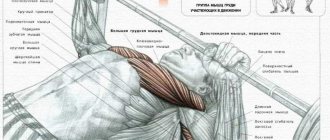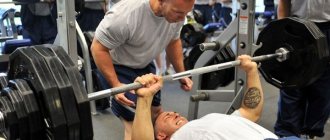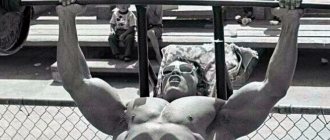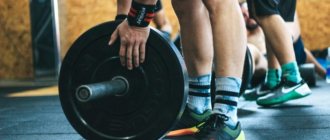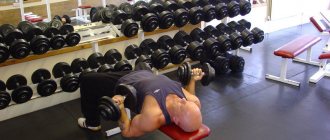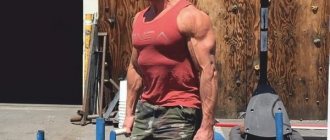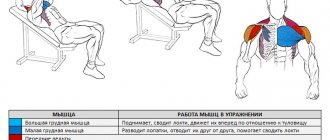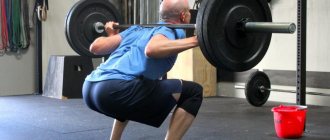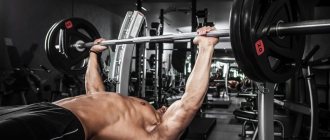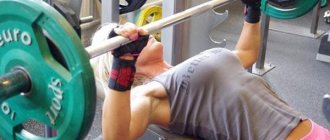Muscles involved in the bench press
The upper body is constantly involved in sports movements such as pushing and throwing. The muscles most involved in this activity are the pectoralis major, anterior deltoid and triceps. The pectoralis major muscle is a large muscle consisting of three parts (clavicular, pectoral and costal). Overall, this muscle acts as a powerful medial rotator and adductor of the arm. The anterior deltoid helps the pectoralis major to flex the shoulder, while the triceps is the primary elbow extensor.
The bench press is one of the most commonly used exercises for upper body training or as a measure of strength. Competitive bench press athletes use numerous variations of the bench press to isolate and train the shoulder girdle muscles, which contribute significantly to performance.
Methodological and technical errors in the bench press
- Insufficient warm-up or lack thereof. This error is not specific to this exercise. This is a general requirement for all types of physical activity. A bad warm-up has disastrous consequences. At first, microtraumas that are invisible at first glance are possible. Subsequently, the situation may worsen and lead to serious problems. Moreover, a gradual approach to working weight tunes psychomotor connections for the hard work ahead.
- Changing the starting position during a motor action. Most often, the practitioner lifts his pelvis off the bench. Shortening the range of motion and overstraining the lumbar spine. Such an attempt will not be counted in competitions.
- Incorrect grip width, the definition of which was described above. As well as an open grip (thumb on top of the bar). There is a possibility of the barbell falling (slipping) from the palms. Or weak grip strength on the bar.
- Lifting the barbell from the racks using the triceps and pectoral muscles. When the bar is above the bridge of the nose, it is easiest to remove the barbell using the trapezius muscles. Bring your shoulders and collarbone forward.
- Uncontrolled descent of the projectile. It is necessary to counteract the weight of the projectile in the negative phase. The chop press is only possible with special equipment.
- Deviation from a given trajectory of movement (most often this is placing a projectile on the head). Also perform the exercise asymmetrically.
- Incorrect or neglected insurance. Insurance, like everything else, needs to be learned. There are certain rules. Therefore, the belayer is part of the process. Accordingly, he must be competent in this. This is especially true for exercises with extreme weights or repetitions.
What does the incline of a bench press bench affect?
In fact, many studies show that the bench press is the best exercise for developing chest muscles (1). Bench incline is one of the variables used to change muscle activity during the bench press. In particular, by changing the angle of the bench, you can achieve the greatest activation of the muscles of the upper or lower pectoralis major muscle (2).
Previous studies have shown that decreasing the incline angle of the bench press activates the lower portion of the pectoralis major muscle (2, 3, 4), the horizontal bench press activates the sternocostal portion, and the upward incline activates the upper, clavicular portion (5, 6). For this reason, it is generally accepted that the horizontal bench press is effective in stimulating the middle portion of the pectoralis major muscle, and when the angle of the bench press is higher than horizontal, the EMG activity produced in the upper portion of the pectoralis major muscle is greater.
Bench Press Progression
- It is necessary to develop a stable technique for performing the bench press. Light weights should be used first. Strive to maintain the correct movement, gradually increasing the weight. An indicator of a developed technique is the execution of one repeated maximum without errors.
- Pay special attention to the lagging muscles that are involved in the movement. To do this, you need to use different variations of the press. Different grip, angle, bench press with partial amplitude.
- Work on creating stable neuromotor connections. Ideomotor training (mental, conscious representation and sensation of a motor action) will be of great help in this.
- When planning rest days (at least 72 hours), take into account that the period of mental recovery is longer than physical. Therefore, the optimal frequency of bench press training will be once every five days;
- Alternating between light and hard workouts. In this case, it is necessary to observe the undulation of the training cycle. Long enough progress in the bench press can provoke long-term stagnation. Therefore, it is necessary to deliberately reduce working weights by 10–20%. Then it is possible to increase the repeated maximum by 3–5%.
- The main part of the workout lasts no more than 40 minutes. Moreover, if this is a power load (up to three repetitions), then the rest between approaches can be up to five minutes. The number of approaches is from three to six. In strength endurance training (five to ten repetitions), pause between sets for no more than three minutes. The total number of approaches is from four to eight.
- Avoid asymmetric development of antagonist muscles. Along with presses, include traction exercises, as well as movements to develop general strength and coordination (standing press, squats with a barbell overhead).
These rules are suitable mainly for beginner and intermediate levels. Competitive athletes use a slightly different concept of the training process.
First, you need to know exactly your working weights, as well as one repetition maximum (RM). For this, there are many tables with the coefficient for calculating it. But it would be better to determine it empirically, through several training sessions. As long as you follow the correct technique.
Research methodology
However, many such studies have not examined the simultaneous use of other muscles involved in the bench press. Therefore, the purpose of this study was to evaluate the levels of EMG activity in three sections (clavicular, pectoral and costal) of the pectoralis major muscle, as well as in the anterior deltoid muscle and triceps (medial head) during bench press performance at five bench angles (0°, 15°, 30°, 45°, and 60°).
Thirty young, healthy, and physically active adults voluntarily participated in the study. They had at least 1 year of resistance training experience, training at least three times per week.
Muscle EMG activity was recorded at the aforementioned inclines at 60% of one repetition maximum (1RM), which was determined for each incline and each participant in advance during study preparation.
As you would expect, as the angle of the bench increased, the amount of weight used became lower. That is, at an angle of 0° the athlete could squeeze out noticeably more weight than at an angle of 60°.
The results showed that maximum EMG activity for the upper chest occurred at a 30° inclination. The middle and lower parts showed higher EMG activity at 0° bench inclination.
The anterior deltoid had the highest EMG activity at 60°. The triceps showed similar EMG activity at all bench angles. The change in the activity of a particular muscle or muscle area depending on the angle of the bench is clearly shown in the graph below (blue line - triceps, lilac - deltoid, red - lower chest, green - middle, brown - upper).
Execution technique
Initial position
To successfully perform the bench press, it is necessary to create a rigid biomechanical structure. Therefore, it is necessary to provoke a compression load in the back and buttocks. Place your feet approximately shoulder width apart. Take a lying position under the apparatus. The back is straight. The projection of the bar is on the chin or below. Then, without lifting your foot from the support, move even further under the bar, due to the deflection in your back and pelvis. Bring your shoulder blades together. Now the bar should be clearly above the bridge of the nose. Grasp the bar with a closed grip (thumb underneath). The grip width should be determined in advance based on the rules described above. The bar lies closer to the carpal part of the hand. Look up.
Removing the rod
The projectile should be removed using the force of the trapezius muscles. At the same time, the collarbone moves forward. The shoulder blades rest securely on the bench. The bar should be over the center of your chest. Pause 2–3 seconds. Half-breath.
Motor action
Lower the projectile under control (relatively slowly) to a given point. After a short pause, push the barbell up with a powerful force, giving it acceleration and pressing the shoulder blades into the bench, without losing compression in the buttocks and back muscles. In this case, the position of the body does not change.
Completing the exercise
Using the force of the trapezius muscles, place the projectile on the racks. The described technique is common to all variations of the press. Although, depending on each specific case, there are subtleties.
Conclusions: how the angle of the bench affects muscle activity
This study confirms that the bench press angle influences the EMG activity of various regions of the pectoralis major and anterior deltoid muscles. The horizontal bench press produces homogeneous electromyographic activity in three regions of the pectoralis major muscle and the anterior deltoid muscle. In contrast, a 30° tilt results in greater activation of the upper chest. At bends above 30°, there is significantly greater activation of the anterior deltoid muscle, which significantly reduces EMG activity in three chest regions (7).
Breast
The chest muscles, like the muscles of the hips and back, have significant mass. This group is represented by the pectoralis major, pectoralis minor and serratus anterior. The pectoralis major
muscle originates from the sternal part of the clavicle, the edge of the sternum and the cartilages of the fifth and sixth ribs.
Attaches to the crest of the greater tubercle of the humerus. Adducts, pronates and pulls the humerus forward. The pectoralis minor
is located under the major one.
It starts from the second to fifth ribs, attaches to the coracoid process and pulls the scapula down and forward. The serratus anterior,
with nine teeth, begins on the second to ninth ribs. Attaches to the medial edge of the scapula and its inferior angle. Pulls the scapula forward and its lower angle outward. When the arm is abducted, it raises the arm above the level of the shoulder joint. Bodybuilders are focused on maximum development of the pectoralis major muscle and all exercises for it are divided into three sets that specifically load the corresponding area.
Practical application: which angle to choose?
The horizontal bench press is a recommended exercise for maintaining or improving dynamic upper body performance. To increase the performance of the anterior deltoid muscle, it is recommended to use a bench inclination greater than 45°.
High activation of the anterior deltoids during the bench press is a variable that should be considered when programming strength training.
Sources:
- Welsch, E. A.; Bird, M.; Mayhew, J. L. Electromyographic Activity of the Pectoralis Major and Anterior Deltoid Muscles During Three Upper-Body Lifts. J. Strength Cond. Res. 2005, 19, 449–452.
- Lauver, J. D.; Cayot, T. E.; Scheuermann, B.W. Influence of bench angle on upper extremity muscular activation during bench press exercise. Eur. J. Sport Sci. 2016, 16, 309–316.
- Saeterbakken, A.H.; Mo, D.-A.; Scott, S.; Andersen, V. The effects of bench press variations in competitive athletes on muscle activity and performance. J.Hum. Kinet. 2022, 57, 61–71.
- Glass, S.C.; Armstrong, T. Electromyographical activity of the pectoralis muscle during incline and decline bench presses. J. Strength Cond. Res. 1997, 11, 163–167.
- Barnett, C.; Kippers, V.; Turner, P. Effects of variations of the bench press exercise on the emg activity of five shoulder muscles. J. Strength Cond. Res.1995, 9, 222–227.
- Trebs, A.A.; Brandenburg, JP; Pitney, WA An electromyography analysis of 3 muscles surrounding the shoulder joint during the performance of a chest press exercise at several angles. J. Strength Cond. Res. 2010, 24, 1925–1930.
- David Rodríguez-Ridao, José A. Antequera-Vique, Isabel Martín-Fuentes, José M. Muyor. Effect of Five Bench Inclinations on the Electromyographic Activity of the Pectoralis Major, Anterior Deltoid, and Triceps Brachii during the Bench Press Exercise. Int J Environment Res Public Health. 2022 Oct 8;17(19):E7339.
